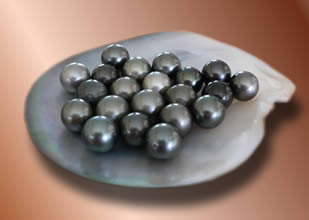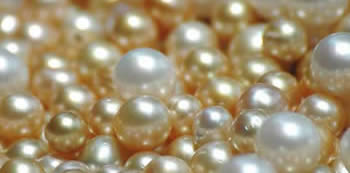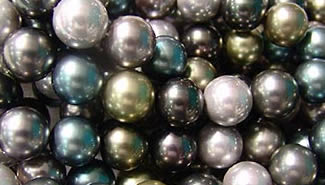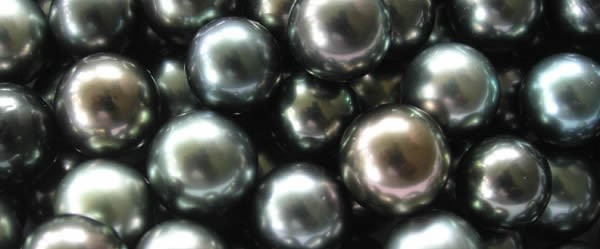Your Details
Your Details
GemSelect Newsletter - The Queen of Gems: A Brief History of PearlsThe pearl has been an aspect of various cultures, far and wide. Pearls today are known as "the queen of gems" and rightfully so, as they symbolize unblemished perfection, modesty and purity. It is said that promises of health and longevity follow those who are adorned with pearls. The unparalleled beauty of nature's lustrous pearl has aroused passion, desire and fascination from all ends of the earth since before recorded history. Without a doubt, pearls are one of the oldest-known gemstones and not surprisingly, no records exist of their first origins or discovery. 
Natural Pearls
One can only assume how pearls were discovered in the beginning. The most widely accepted theory is that pearls were first discovered whilst man was scavenging for meals along the coasts. Upon man's first glance, pearls were forever destined to be treasured for eternity. Pearls in Ancient Times
Pearls have endured like no other gemstone. For centuries, pearls were prized as one of the most valuable gems and still to this day, have remained one of the most prominent jewels since the ancient times. People once believed that pearls were directly connected with the moon, and thus possessed magical powers. Pearls have been referenced throughout ancient mythology, folklore and even biblical scriptures. Amazingly, the oldest-known gem that was worn as jewelry, is a piece of pearl that dates back to around 520 B.C. This astoundingly ancient artifact was discovered in the sarcophagus of a Persian princess and put on display in the Louvre Museum in Paris. 
Beautiful Pearls
The ancient Egyptians were particularly fond of their pearls. Many Egyptian leaders treasured pearls so much, that they were often buried along with their cherished pearl collection. One tale that has been passed through the ages, tells of how Cleopatra once crushed a pearl and dissolved it in a glass of vinegar (some believe Egyptian wine-vinegar), just to show Marc Anthony that she could host the most expensive meal in history. The Romans considered pearls to be an absolute, quintessential symbol of status, and during ancient Roman times, the value of pearls was tremendously high. It's even believed that a Roman general once funded an entire military campaign, just through the sale of a pair of his mother's pearl earrings. Another belief is that Caligula, in 41 A.D., famously made his horse a consul to his vast empire and adorned it with a lavish pearl necklace. The Greeks held pearls in very high regard, as did the ancient Egyptians and Romans. The ancient Greeks used pearls for romantic customs and ceremonies, since pearls were regarded as symbols of love, devotion and marriage. The Greek word for "pearl" means "unique", and this alone, is further testament to the fact that no two pearls are alike. Worn by brave knights heading off into battle, as symbols of strength and spirit, pearls were seen as a magical icon throughout the Dark Ages, often representing courage and protection. However, by the time of the Renaissance, pearls had eventually evolved into a symbol of wealth and social status. Laws would soon be passed, declaring that only nobles could wear them in public, despite a surplus of pearls being imported and available. 
GemSelect Natural Pearl Selection
Pearls and the Americas
The Native Americans first discovered pearls along the Atlantic Coast and the freshwater basin of the great Mississippi. Native Americans cherished pearls and both men and women would wear them for their great beauty. Pearls were often used for trading between tribes and the mussel shells were even used as decorations on tribal attire. Native Americans also used pearls during ceremonial celebrations for paying tribute to their great warriors and leaders; it's believed that Powhattan, the father of Pocahontas, had a large collection of pearls that were given to him for his courageous acts in battle. When Europeans began to explore the Americas, pearls were shortly discovered amidst the waters of Central America and swiftly imported back to Europe. However, due to greed and overzealousness, by the 17th century, Europeans had virtually depleted the pearl and oyster population. In South America, the Spanish explorers encountered more pearl-rich waters. Prior to Spain's discovery of pearls in these lands, the great ancient tribes of South America had already been long using pearls for their natural beauty. Prized and coveted by the Incas and Aztecs, pearls were used in everyday decorations, rituals and traditional ceremonies. Pearls in the 20th Century

Tahitian Pearls
In the early 1900s, Mikimoto Kokichi, the son of a Japanese noodle chef, discovered revolutionary techniques for pearl production. Through injecting a chemical formula directly into an oyster, he was able to stimulate the pearl into forming nacre. Simultaneously, around the turn of the 20th century, natural pearls became more affordable and accessible in Europe, thus allowing people to more easily acquire pearls. Pearls were commonly being given as the "ultimate wedding gift", due to the virtue and purity the pearls represented. In the Eastern world, pearls were being used in Hindu and Islamic marriage ceremonies as well; pearls were known to be a representation of innocence and perfection for these cultures. Pearls today are much more affordable and available than before, but there are still extravagant pearls being bought and sold today, demanding remarkably high prices. In 1917, a French jeweler, by the name of Jacques Cartier, famously bought his "Cartier" store on Fifth Avenue, New York, with just two incredibly exquisite pearl necklaces. Some 40 years later, one of these necklaces fetched an incredible $157,000 at an auction. Today, pearl-lovers are spoiled with affordable prices and higher quality standards (compared to generations before). In fact, even the most modestly priced cultured pearl can rival the quality of an extravagant and expensive natural pearl. Because of this, pearls can now be worn and admired by all ages and nations. 
Tahitian Pearls
Keep up with our new arrivals before they hit the newsletter by joining our thousands of fans and followers on our social networking pages. We love interacting with our customers - you can visit us on Tumblr, LinkedIn, Twitter, Facebook or Pinterest! To ensure you can receive our emails, please be sure to add help@gemselect.com to your list of safe contacts, or you add us into your email address book! Please feel free to contact us with any questions, comments and queries! We respond to each and every email we receive. Happy Gem Hunting! |
